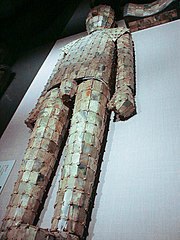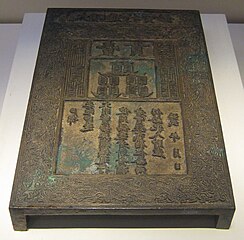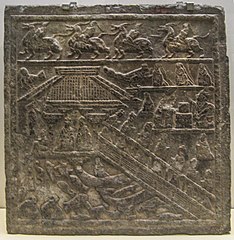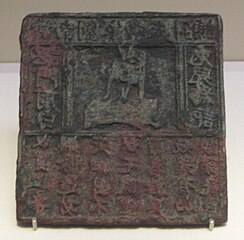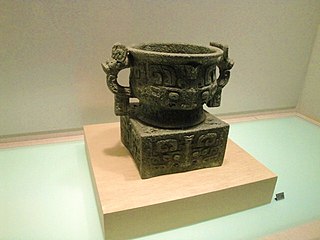National Museum of China
中国国家博物馆 | |
Tian'anmen East | |
| Website | en |
|---|---|
The National Museum of China is the national museum of China. It flanks the eastern side of Tiananmen Square in Beijing, China. The National Museum of China has a total construction area of about 200,000 square meters, a collection of more than 1.4 million items, and 48 exhibition halls. It is the museum with the largest single building area in the world and the museum with the richest collection of Chinese cultural relics.[3] It is a level-1 public welfare institution funded by the Ministry of Culture and Tourism.[4]
History

The current form of the legal entity of the museum was established in 2003
The building was completed in 1959 as one of the Ten Great Buildings celebrating the ten-year anniversary of the founding of the People's Republic of China. It complements the opposing Great Hall of the People that was built at the same time. The structure sits on 6.5 hectares (16 acres) and has a frontal length of 313 metres (1,027 ft), a height of four stories totaling 40 metres (130 ft), and a width of 149 metres (489 ft).[6] The front displays ten square pillars at its center.

After four years of renovation, the museum reopened on March 17, 2011, with 28 new exhibition halls, more than triple the previous exhibition space, and state of the art exhibition and storage facilities. It has a total floor space of nearly 200,000 m2 (2.2 million square feet) to display.[7] The renovations were designed by the German firm Gerkan, Marg and Partners.[8]
The museum's "Road to Rejuvenation" exhibit was the site for Xi Jinping's November 2012 articulation of the Chinese Dream political concept.[9]: 56 The first half of the exhibit documented China's century of humiliation.[9]: 56 The second half depicted China's virtues in overcoming that adversity, the Chinese Communist Revolution, and establishing the People's Republic of China.[9]: 56-57 After touring the exhibit, Xi addressed the media, announcing, "Realizing the great rejuvenation of the Chinese nation is the greatest dream of the Chinese nation in modern times."[9]: 57
Due to the
Collections
The museum, covering Chinese history from the
Among the most important items in the National Museum of China are the "
The museum has a permanent exhibition called The Road to Rejuvenation, which presents the recent history of China since the beginning of the First Opium War, with an emphasis on the history of the Chinese Communist Party (CCP) and its political achievements.[14]
The exhibit hall addressing the life of Deng Xiaoping includes the Stetson hat he was given during at a rodeo during his 1979 visit to the United States.[15] Pictures of Deng donning the hat became a famous image of the visit.[15]
On April 9, 2021, the exhibition "Field of Hope: A National Photographic Exhibition on 'Poverty Alleviation and Sharing a Moderately Prosperous Society'" opened at the museum. The exhibition, hosted by the China Federation of Literary and Art Circles, the National Museum of China and the China Photographers Association, features 180 photographs by nearly 150 different photographers, showcasing the country's effort in alleviating poverty.[16]
Gallery
-
A Han dynasty jade burial suit laced with gold thread at the National Museum of China
-
A pastel pierced porcelain vase, from the Qianlong era of the Qing dynasty
-
Copperplate for printing the Great Ming one string banknote
-
Stone carving from the Eastern Han dynasty, with depiction of a waterside pavilion overlooking a lake full of fish, turtles, and waterfowl
-
Bronze two-part pass (paizi) with a four character Tangut inscription inlaid in silver, from the Western Xia
-
Abronze vessel in the shape of a owl, from the tomb of Lady Fu Hao, from Shang dynasty, 13th century BC
-
Pottery roof tile ends from the Western Han dynasty
-
Painted stone relief depicting a warrior from the Later Liang dynasty
-
Red lacquer box from the Qing dynasty
-
Painted pottery of neolithic Yangshao culture, with depiction of a stork catching a fish and a stone axe on the side
-
Bronze tallies with inscriptions inlaid in gold from the Warring States period, Chu State
-
Brick relief depicting two scholars and two maids, from theSouthern dynasties
-
Bronze plate for printing an advertisement for the Liu family needle shop at Jinan, Song dynasty. The earliest extant example of a commercial advertisement
-
Bronze cannon with inscription dated the 3rd year of theZhiyuan Era (1332), Yuan dynasty
-
Guoji Zibai pan, from Western Zhou
-
Li gui, the earliest Zhou dynasty bronze vessel to be discovered, and the only epigraphic evidence of the day of the Zhou conquest of Shang
-
Houmuwu Ding, the largest piece of bronze work found in the world so far. It was made in the late Shang dynasty at Anyang
-
Eagle-shaped pottery of neolithic Yangshao culture
-
A Song dynasty copy of the Portraits of Periodical Offering of Liang, dated to the 6th century, depicting ambassadors from various tributary states
Countdown clocks
Because of its central location in Tiananmen Square, the front of the museum has been used since the 1990s for the display of countdown clocks relating to occasions of national importance, including the 1997
Controversies
A three-month exhibition of the
Some critics have also alleged the museum's modern historiography tends to focus on the triumphs of the CCP, while minimizing or ignoring politically sensitive subjects such as the Great Leap Forward and the Cultural Revolution.[18]
See also
- List of largest art museums
- List of most visited art museums
- List of museums in China
- Palace Museum
- National Palace Museum
- State Administration of Cultural Heritage
- Ministry of Culture
Bibliography
- Kirk A. Denton, Exhibiting the Past: Historical Memory and the Politics of Museums in Postsocialist China (University of Hawaii Press, 2014), pp. 33–39, 45–74.
References
- ^ "National Museum Annual Report Information System". NCHA. Archived from the original on 2022-10-23. Retrieved 2022-10-25.
- ^ "Wang Chunfa became the director of NMC". Wangyi News. 2018-01-04. Archived from the original on 2018-01-05. Retrieved 2018-01-05.
- ^ "中国国家博物馆正式开馆 藏品数量120余万件-中新网". www.chinanews.com.cn. Retrieved 2024-03-31.
- ^ "中国国家博物馆2023年度公开招聘工作人员公告 _中华人民共和国人力资源和社会保障部". www.mohrss.gov.cn. Retrieved 2024-03-31.
- ^ "Message from NCM Director (Wang Chunfa)". en.chnmuseum.cn. Archived from the original on October 3, 2016. Retrieved November 30, 2018.
- ^ "The National Museum of Chinese History". www.china.org.cn. Archived from the original on 2010-04-15. Retrieved 2023-07-19.
- ^ "China's National Museum to reopen on April 1". Archived from the original on 2017-02-16. Retrieved 2011-02-24.
- ^ "ZEIT ONLINE | Lesen Sie zeit.de mit Werbung oder im PUR-Abo. Sie haben die Wahl". www.zeit.de. Archived from the original on 2018-01-28. Retrieved 2023-07-19.
- ^ S2CID 252800309.
- ^ "The Art Newspaper", List of most-visited art museums, 30 March 2021
- ^ "National Museum gets major makeover". China Economic Review. 2011-02-21. Archived from the original on 2017-08-16. Retrieved 2012-06-03.
- ^ a b c d e f "The National Museum of China". China Culture. Archived from the original on 2014-05-27.
- ^ Luo Bozhao qianbixue wenji by Ma Feihai, Zhou Xiang, Luo Jiong, Luo Bozhao, review by Helen Wang The Numismatic Chronicle, Vol. 165 (2005), pp. 413-414
- )
- ^ ISBN 978-1-350-23394-2.
- ^ "Field of Hope: A National Photographic Exhibition on 'Poverty Alleviation and Sharing a Moderately Prosperous Society'". National Museum of China. Archived from the original on 2021-04-09. Retrieved 2021-04-14.
- ^ a b "National museum, LV reject criticisms of design exhibition". Global Times. June 1, 2011. Archived from the original on 2012-06-05. Retrieved 2012-01-17.
- ^ Ian Johnson (April 3, 2011). "At China's New Museum, History Toes Party Line". The New York Times. Archived from the original on 2012-01-15. Retrieved 2012-01-17.

